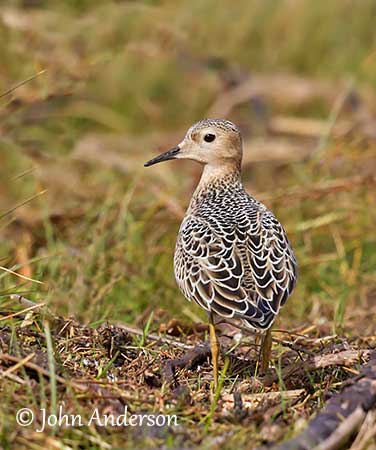Fr: Bécasseau roussâtre – Bécasseau rousset
Ang: Buff-breasted Sandpiper
All: Grasläufer
Esp: Correlimos Canelo
Ita: Piro piro fulvo
Nd: Rustsnipe
Sd: prärielöpare
Photographers:
John Anderson
John Anderson Photo Galleries
Otto Plantema
Trips around the world
Text by Nicole Bouglouan
Sources:
HANDBOOK OF THE BIRDS OF THE WORLD Vol 3 by Josep del Hoyo-Andrew Elliott-Jordi Sargatal - Lynx Edicions - ISBN: 8487334202
SHOREBIRDS by Peter Hayman, John Marchant and Tony Prater – Christopher Helm – 1986 – ISBN: 0747014035
GUIDE DES LIMICOLES de D. Taylor - Delachaux et Niestlé - ISBN : 2603014080
All About Birds (Cornell Lab of Ornithology)
Bird Web (Seattle Audubon Society)
What Bird-The ultimate Bird Guide (Mitchell Waite)
Buff-breasted Sandpiper
Tryngites subruficollis
Charadriiformes Order – Scolopacidae Family
INTRODUCTION:
The Buff-breasted Sandpiper is one of the three groung-lekking Scolopacidae, alongside the Great Snipe and the Ruff. The male displays its white underwing contrasting with the dark background of the tundra’s landscape. These displays involve fluttering, stretching and turning of the white open wings. However, the male often displays with other males on an arena or lek, but it may also display alone.
This species breeds in the open Arctic tundra of North America and extreme NE Siberia, and Wrangel Island. It winters in S America, especially in Argentina.
The Buff-breasted Sandpiper was formerly abundant, but following heavy hunting in late 1800s and early 1900s, and now habitat loss on wintering areas, the species is currently considered Near Threatened.
DESCRIPTION OF THE BIRD:
Biometrics:
Length: 18-20 cm
Wingspan: 43-47 cm
Weight: 43-94 g
The Buff-breasted Sandpiper is a medium-sized wader with rich buff face and underparts, paler on belly, vent and undertail-coverts, and faintly mottled breast.
On the underwing, the lesser coverts are deep buff. The primary coverts are conspicuously mottled dark brown, and show a bold subterminal bar. Axillaries and rest of underwing are silvery-white. The underside of both flight-feathers and rectrices is mottled with dark brown spots on the pale background.
On the upperparts, mantle, scapulars, rump, wing-coverts and uppertail are buffy-brown with dark brown feather centres. The flight-feathers, outer greater coverts and primary coverts are fringed buffy-white and show a dark, subterminal spot or bar. On the uppertail, the two central rectrices are almost all-dark.
Crown and hindneck are spotted blackish.
The short, straight bill is dark brown with yellow tinge at base of lower mandible. The eyes are brown with faint whitish area around the eye. Legs and feet are olive-yellow to bright yellow.

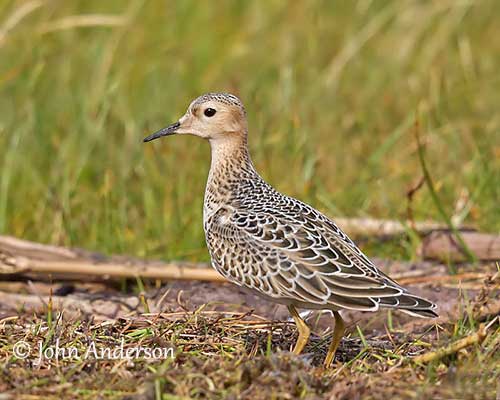
Male and female have similar plumage, but the female is smaller than male. In winter, the adult shows broader and browner, less buff edges to upperpart feathers.
The juvenile resembles adult with paler underparts, mainly on lower belly and vent. The upperparts show narrower fringes and dark subterminal bars to feathers.
RANGE:
The Buff-breasted Sandpiper breeds along the coasts of Wrangel Island, Ayon Isla nd and N coast of Chukotka, and N Canada, E in N Canada to Boothia Peninsula, and sometimes N to Devon Island.
It winters in S America from SE Bolivia, Paraguay and S Brazil to Uruguay and NE Argentina. It migrates through the Caribbean to reach its wintering grounds.
HABITAT:
The Buff-breasted Sandpiper breeds in the high Arctic on tundra slopes and ridges, with mosses, willows and grass, also in wet meadows with sedges and grass. It usually avoids the marshy areas, and rarely nests near the sea. The leks are established on vegetated, hummocky areas around marshy ponds.
During the migration, it frequents mainly dry open ground including meadows, pastures, golf courses, stubble fields and burnt grassland.
It winters on flooded pampas or in short vegetation near wetlands.
It can be seen up to 2550 metres of elevation in Bolivia, and 3300 metres on passage in Ecuador.
CALLS AND SONGS: SOUNDS BY XENO-CANTO
The Buff-breasted Sandpiper is usually silent, but during the displays, the male gives rapid clicking sounds such as series of repeated “tick” notes.
The alarm call is a low trilling noise, and the bird gives a “churh” when flushed. In flight, it utters a growling “pr-r-r-reet”.
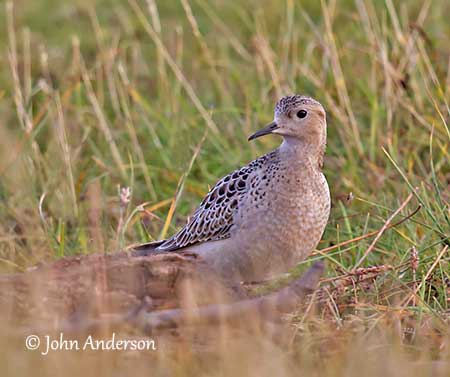
BEHAVIOUR IN THE WILD:
The Buff-breasted Sandpiper feeds mainly on insects, mostly flies, crane flies and midges, beetles and other insect species on the breeding grounds. During migration, in addition to insects, it also feeds on spiders and small crustaceans, and sometimes seeds.
It forages by sight, waiting for prey before making a short run to catch it. Insects and other food items are picked up from ground surface.
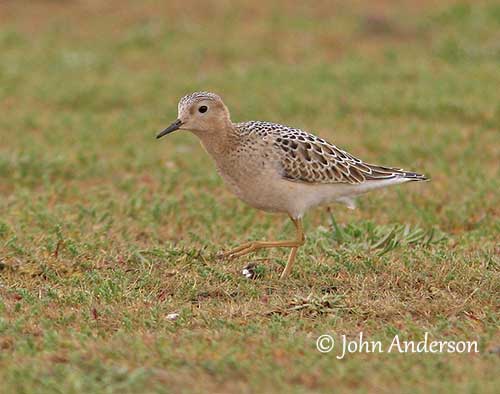
At the beginning of the breeding season, several males (up to ten) display together at leks in order to attract females. Usually, each male defends its territory of up to several acres. During the displays, the male raises one wing to expose the white underside pattern. When a female approaches, it spreads both wings and shakes its body, while the bill is held upwards. Some males also perform solitary displays away from leks.
The males are often polygynous and mate with several females, but they do not take part in nesting duties.
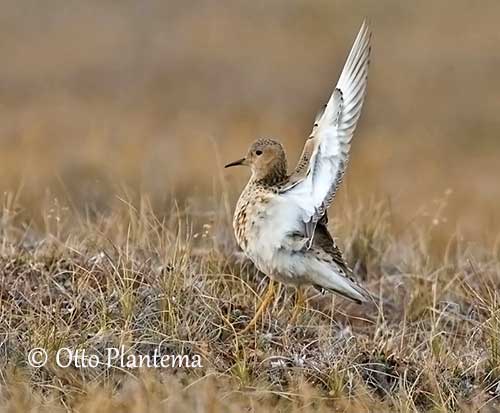
The Buff-breasted Sandpiper is migratory, travelling through interior N America (Canadian prairies and C USA) across Gulf of Mexico to N South America. It flies through interior south-American continent to reach its wintering grounds, but the staging sites are poorly known.
They leave the breeding grounds between late July and early September. They reach the wintering areas in mid-September/mid-October. The return migration to N starts in late January/early February to late March. They arrive farther N until mid-June. They probably migrate by night and in flocks.
There are frequent records in UK, Ireland, France, and Netherland. It is vagrant to rest of Europe, Greece, Oman, Asia, Japan, Korea, Taiwan, and in Africa, Australia, New Zealand, New Guinea and Oceania.
The Buff-breasted Sandpiper has swift flight with rapid wingbeats.
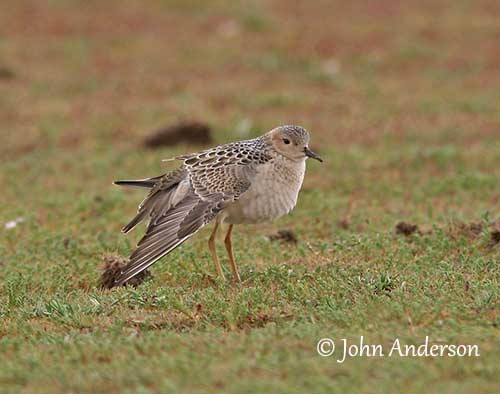
REPRODUCTION OF THIS SPECIES:
The egg-laying occurs through June. The nest is on the ground and usually near water. The female builds a shallow depression on a hummock of moss. It is lined with leaves, sedges, moss and lichens.
She lays 4 dull white/buff/olive eggs with dark markings. She incubates alone during 23-25 days. At hatching, the chicks are brownish-grey above with dark mottling and white tips, the underparts are whitish and the crown is dark. They leave the nest within 24 hours after hatching, and they are able to feed themselves. They are tended by the female. They fledge about 16-20 days after hatching.
PROTECTION / THREATS / STATUS:
The Buff-breasted Sandpiper was led almost to extinction by heavy hunting in the early 1900s. Today, the breeding grounds are affected by degradation of the habitat, and the birds are poisoned by environmental contaminants. They are also threatened by toxic chemical and pollutants in the cultivated areas during migration and winter.
The global population is estimated to number 16,000/84,000 individuals, with a maximum of 30,000 birds. This population is suspected to be declining due to habitat loss and contaminants.
The Buff-breasted Sandpiper is currently considered Near Threatened.
